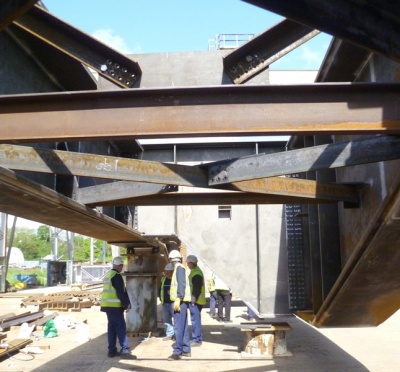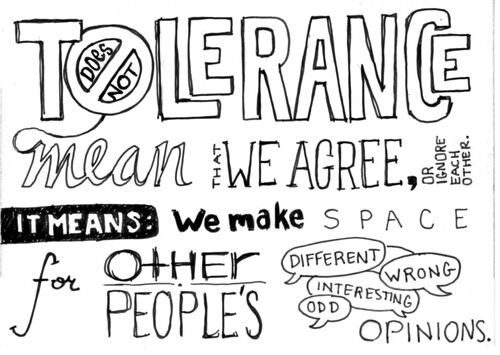This post is an assigned in response to a 2012 post by Paul
Louis Metzger entitled “Beyond
Tolerance to Tenacious Love”
 Much has been written about cultural tolerance and
intolerance in the last 20 years. It is surprising that tolerance has almost
come to mean intolerance. In relational terms, tolerance is what we call it when
we can converse, and even work together, civilly, despite the fact that we have very
different beliefs and values. Finding common points of agreement or safe meeting
places is important if we are going to build effective bridges.
Much has been written about cultural tolerance and
intolerance in the last 20 years. It is surprising that tolerance has almost
come to mean intolerance. In relational terms, tolerance is what we call it when
we can converse, and even work together, civilly, despite the fact that we have very
different beliefs and values. Finding common points of agreement or safe meeting
places is important if we are going to build effective bridges.
Unfortunately, in a tidal wave of political correctness,
what was once tolerance (disagreeing civilly) has been twisted to require
agreement with the current anti-conservative (politics), anti-Christian
(religion), and anti-traditional values (morality) agenda and not speaking or
advocating for anything that disagrees with it. I am a fan of the original
definition and dismayed by the controlling influences of the second. Relational
intolerance is when we can’t have a normal, civil, human, conversation with
those who disagree with some position, belief, or behavior we hold dear. If
those in power are intolerant they will tend to compel those who disagree to
agree—using any methodology and coercive force available to them. This behavior is not relational
at all.
 In terms of physical bridge-building, the word “tolerance”
has a number of different applications. Members meeting together atop a pier
are to fit together according to the tolerance standards for the materials.
With steel construction, gaps of more than 1/16 of an inch need to be shimmed and
filled. Translating this metaphor of bridge-building tolerance into relational and
cultural terms, “Tolerance and intolerance,” as Paul Louis Metzger suggests, “do not function
as properties of beliefs but of behaviors. If tolerance were to be framed as a
matter of acceptance of another person's (or tradition’s) belief system, then
anyone who rejects my belief system as true would be intolerant.” However, that
doesn't mean we can’t work out a protocol for how we can meet and work
together. But we might need to drive slowly!
In terms of physical bridge-building, the word “tolerance”
has a number of different applications. Members meeting together atop a pier
are to fit together according to the tolerance standards for the materials.
With steel construction, gaps of more than 1/16 of an inch need to be shimmed and
filled. Translating this metaphor of bridge-building tolerance into relational and
cultural terms, “Tolerance and intolerance,” as Paul Louis Metzger suggests, “do not function
as properties of beliefs but of behaviors. If tolerance were to be framed as a
matter of acceptance of another person's (or tradition’s) belief system, then
anyone who rejects my belief system as true would be intolerant.” However, that
doesn't mean we can’t work out a protocol for how we can meet and work
together. But we might need to drive slowly!
On the Southwest side of Portland, there is a bridge—a flyover
exit ramp—connecting I-5 and Highway 217 that was notorious for traffic
accidents related to a variety of tolerance issues. One such issue was
the gap in the joint between two sections.
According to a May 2014 article by Joseph Rose on the Oregonian’s
website, “The transportation agency [ODOT] said
the road joint that is gradually splitting apart had likely contributed to more
than a dozen crashes in three weeks. The teeth of the huge metal seam
are popping up and may be tripping up the tires on vehicles traveling
faster than the 35 mph advisory speed, especially in rainy weather, ODOT said.”[1]
As you can tell from the photo, the joint is not only separating
but is not the same height.
 |
| Note ground-down fingers. |
One of the things ODOT did to alleviate the problem besides
posting warning signs for people to slow from freeway speeds to 35 mph, was to
grind down the fingers on the high side of the joint.
Finally, ODOT worked to increase the surface friction to
prevent cars from losing traction when the road was wet. As Joseph Rose writes,
Because ODOT's friction tester is
down for maintenance, we had Washington DOT perform testing with their
equipment," said ODOT pavement management engineer John Coplantz in an
email to managers. Tests on the deck seal showed it was losing its grip, with
some readings showing it was below acceptable "friction values."
"These numbers by themselves
do not necessarily represent an unsafe condition," Coplantz wrote.
"However, roadway geometry, vehicle speeds, and driver expectations place a
high demand on surface friction at this location."[2]
Just as bridge joints can shift and spread under load, it seems that the same things often happen in our
relational/cultural bridge-building. We start to pull apart at the joints
instead of clinging to each other and the road with the “tenacious love” Paul Louis Metzger speaks of. How wide are our gaps? How strong is our grip? The warning of wisdom tells us to slow down, watch the road,
and let the bond of God's love keep us from pulling away and/or elevating ourselves above each other when we
are under stress. We are in need of both care and compassion if we hope to begin and maintain a conversation in the midst of a culture that has forgotten how. While we can and should be able to entertain a thought without accepting it, as Aristotle suggests, we shouldn't treat people like that.
[Ironically, this “intolerant” bridge is about three miles down the road from a neighborhood called, Metzger, Oregon.]



No comments:
Post a Comment